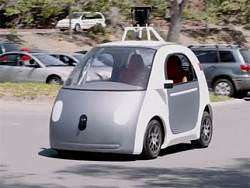California DMV Not Cool with Google's Steering Wheel-Free Car
- OurStudio

- Aug 27, 2014
- 2 min read

In May Google unveiled a car unlike any other: Built in-house, it had no steering wheel or brake or acceleration pedals. Although hype continues to build about the possibilities of a bold redesign, California's Department of Motor Vehicles (DMV) is officially not cool with this breed of autonomous automobile.
The California Department of Motor Vehicles has issued rules that say a driver must be capable of "immediate physical control" of a vehicle. So, the search giant's prototype cars for now will include steering wheels and a brake-pedal system. The company said it would comply with the state's regulations, which will go into effect in mid-September. "During our testing we are equipping the vehicles with manual controls such as a steering wheel, brake pedal, and accelerator pedal," said a Google spokesperson. "With these additions, our safety drivers can test the self-driving features while having the ability to take control of the vehicle if necessary." Testing on private roads will begin next month, in prototypes that will include a steering wheel and pedals. The California DMV is expected to issue another regulation later this year that will let manufacturers apply for permits to operate driverless cars—without steering wheels, brakes or accelerators—in public roads.
So, that kind of defeats the purpose of having a totally driverless car. And, it's not like Google slapped the thing together without any safety and self-regulatory considerations. In fact, greater safety is a big part of the push for self-driving cars. As I wrote when the vehicle debuted:
Google has long been seeking to reduce human error in driving— 90 percent of road accidents are the result of human error—so it removed the human-controlled components. … The prototypes are loaded with sensors that can deal with railroad crossings, indecisive cyclists, and construction congestion. In case of failure, it has "redundant systems for steering and braking." Unlike Google's other cars, which can handle highway speeds, the prototype (for now) tops out at 25 miles per hour, so it will do minimal damage if it bumps somebody with its plastic windshield and thick foam front-end.
The cars could also mean cleaner, more efficient driving, fewer cops on the roads, fewer licensing requirements (who needs a driver's license when you're not actually driving?), less money spent on insurance, and even the obsolescence of speed limits.
What the effects, positive or negative, will be of the DMV's interference in the work of one of the world's most reputable businesses are yet unknown, but as has been previously pointed out:
Policy makers must remember that their actions can produce harm. If automated vehicles are demonstrated to be significantly safer than manually driven vehicles, any misstep, convoluted law, or rule that leads to unnecessary higher costs or delays translates to increased injury and death.
For a different Reason perspective on self-driving cars and the potential privacy pitfalls, click here.




Comments